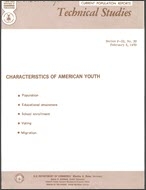Characteristics of American Youth
Characteristics of American Youth
Introduction
This report is a summarization of recent data on the characteristics of the youth of the Nation—age, race, school enrollment, educational attainment, labor force participation, voter participation, and migration—with special emphasis on their educational characteristics.
Some highlights of the data on youth and students are:
POPULATION—On July 1, 1969, there were 39.1 million persons in the United States who were 14 to 24 years old--an increase of 44 percent over the 27.2 million of this age in 1960. They represented 19 percent of the total population in 1969, compared with only 15 percent in 1960. Between 1960 and 1969, the median age of the population declined from 29.5 years to 27.7 years.
The number of young persons of high school age (14 to 17 years old) increased from 11.2 million in 1960 to 15.5 million in 1969. The number of persons of college age (18 to 21 years old) increased from 9.4 million to 14.2 million during the same time.
EDUCATIONAL ATTAINMENT—Young adults are making significant gains in their educational attainment. Among those 25 to 29 years old, 75 percent were at least high school graduates in 1969, as compared with only 61 percent in 1960. The proportion of this age who have completed 4 years of college or more increased from 11 percent in 1960 to 16 percent in 1969.
Significant gains have also been made in the percent of high school graduates who continue their education in college. Among 20- to 24-year-old men who are high school graduates, the percent who have completed some college increased from 42 percent in 1960 to 52 percent in 1969. The comparable increase for women was from 33 percent to 40 percent.
SCHOOL ENROLLMENT—Most of the youth of the Nation are either enrolled in school or, if not enrolled, have at least completed high school. The number of young persons 14 to 24 years old enrolled in school in October 1968 was 35.5 million, or 58 percent of the age group. Almost all of those of high school age, around half of those 18 and 19 years old, and close to one-fifth of those 20 to 24 years old were enrolled in school. Of those 14- to 24-year-olds who were not enrolled in school, nearly 7 out of 10 were at least high school graduates.
There were 6.8 million students in college in the fall of 1968—an increase of 46 percent over the 4.6 million students enrolled in 1964. Of those enrolled in college in 1968, 434,000 were Negroes, or 6 percent of total college enrollment. The number of Negroes in College in 1968 was an 85 percent increase over the number enrolled in 1964.
VOTING—In November 1968, there were 11.6 million persons under 25 years old who were eligible to vote on the basis of age. Of this number, 5.9 million, or 50 percent, reported that they actually had voted in the election of that year. Among persons 25 years old and over, about 70 percent reported that they had voted in November 1968. However, the younger persons were more likely than the older persons to have moved recently and to have been unable to meet the residence requirements for registration.
MIGRATION—The youth of America are highly mobile. For example, among those of college age (18 to 21 years old), about one in three moved between March 1968 and March 1969, and among those 22 to 24 years old, 46 percent moved during the year.
The following tables present a statistical portrait of the demographic and socioeconomic characteristics of American youth. The findings, most of which were published previously, are based largely on results obtained in the October 1968 and March 1969 Current Population Survey conducted by the Bureau of the Census. Some of the results were also obtained from other months of the Current Population Survey, from current population estimates, and from the 1960 Census of Population and earlier censuses. Since the Current Population Survey estimates are based on samples, they may differ somewhat from the figures that would have been obtained from complete censuses using the same schedules, instructions, and enumerators. As in any survey work, the results are subject to errors of response and of reporting as well as being subject to sampling variability. These errors of response and of reporting also exist for census data.
The designs of the samples used for this report provide the greatest reliability for data concerning broad population groups at the national level. Data for small population groups (for example, Negroes 25 to 29 years old with 4 years of college or more) will have larger relative sampling errors. Differences shown in the tables for such small groups May be simply the result of sampling variability and should therefore be used with caution. All statements of comparison made in the text of this report, however, are statistically significant. This means that the chances are at least 19 in 20 that a difference identified in the text indicates a true difference in the population rather than the chance variations arising from the use of samples.
A Note on Language
Census statistics date back to 1790 and reflect the growth and change of the United States. Past census reports contain some terms that today’s readers may consider obsolete and inappropriate. As part of our goal to be open and transparent with the public, we are improving access to all Census Bureau original publications and statistics, which serve as a guide to the nation's history.
Others in Series
Publication
Publication
Publication




